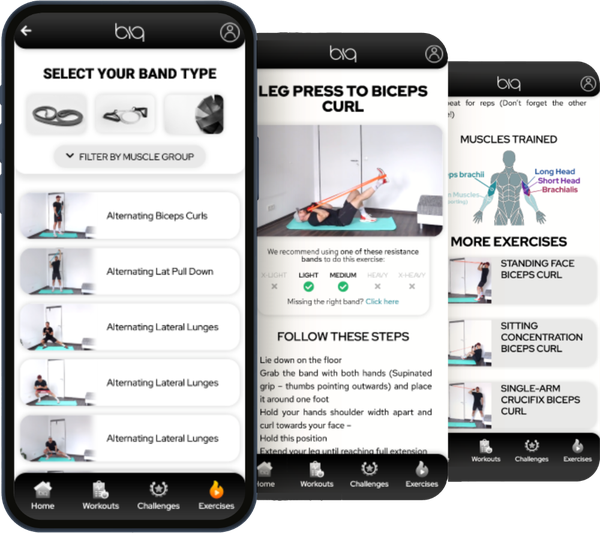Training your calves directly will not only give you great looking lower legs. Having well-trained calves will have a positive effect on every athletic activity. Especially when it comes to running, sprinting or jumping – strong calves will boost these abilities quite a lot. Also, by working directly on your calves, you will become more stable and therefore stronger in compound exercises for your lower body like squats and deadlifts.
Usually you will find heavy machines in gyms to train your calf muscles, where you also have to add quite a lot of weight. So doing effective calf raises at home was really difficult. Fortunately, resistance bands make it possible to work on your calves effectively at home.
To get started, you will be needing a resistance band only. Although, we highly recommend getting a set of bands from the start. This way you will have bands in different levels of resistance. This will guarantee that there is always a band with the right tension available for your current level and for any future progressions. The one we highly recommend is the set right here: Resistance Bands Set.
This article will give you the full knowledge package about calf raises. Starting from a how-to breakdown of the basic movement and important form mistakes to avoid, we will continue to discuss different ways of how to progress and look at variations of the standard exercise. The last section will be all about if and why resistance band training is effective, what benefits it brings along and what specific muscles you will be using in this exercise. Finally, we discuss how to incorporate calf raises in an effective workout routine.
How To Do Calf Raises The Right Way With Resistance Bands?
Before doing any resistance training, make sure to properly prepare your body for the exercises by warming up. This way you will be warm and ready for the workout and also minimize any chance of injury.
You will need just yourself and a resistance band for this exercise. However, we highly recommend wearing shoes to have the band more secure around your feet. In the next section, we will discuss how to properly position and secure the band, so it is locked in place under your feet.
The following 5 steps will guarantee a perfect calf raise:
- Step on the band with both feet – Make sure that the band is under the ball of each of your feet
- Grab the band with both hands, bring your hands up and place the band on your shoulders (you will hold the band in front of your chest)
- Raise your heels
- Return slowly to the starting position (resist against the pull of the band)
- Repeat for reps
Common Form Mistake
⓵ Keep The Band Secure! – The placement of the band is quite important here. By placing the band right under the balls of your feet, you will have it locked in place throughout the whole range of motion of this exercise. Placing any other part of your feet on the band is not a good idea because you will lift your heels. Remember that there is tension in the band, so if you lift your heels, the band is likely to slip from underneath your feet.
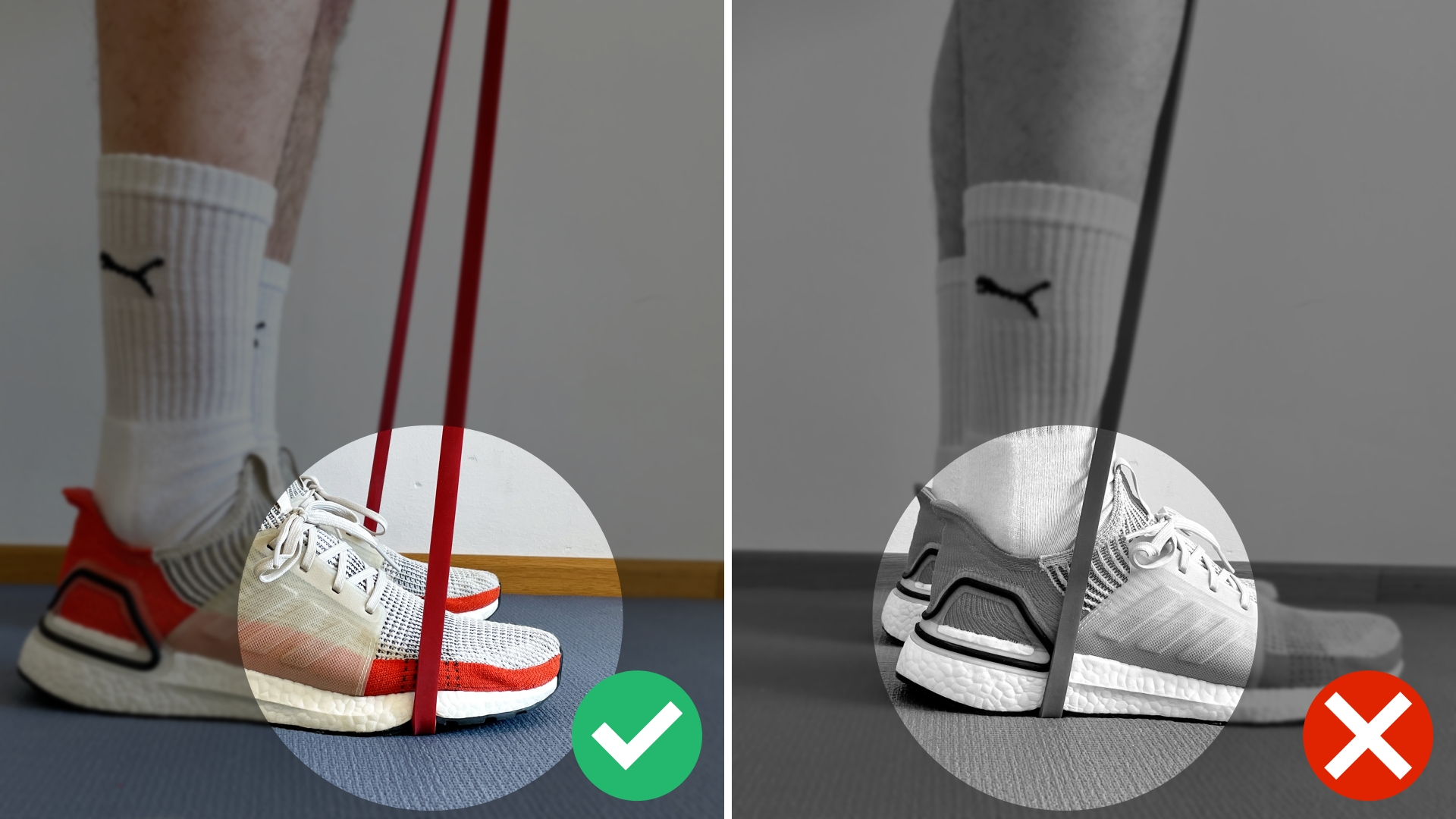
To really keep the band locked in place, I like to wrap it around each of my feet. This will also make the effective length of the band shorter and therefore increase the resistance.
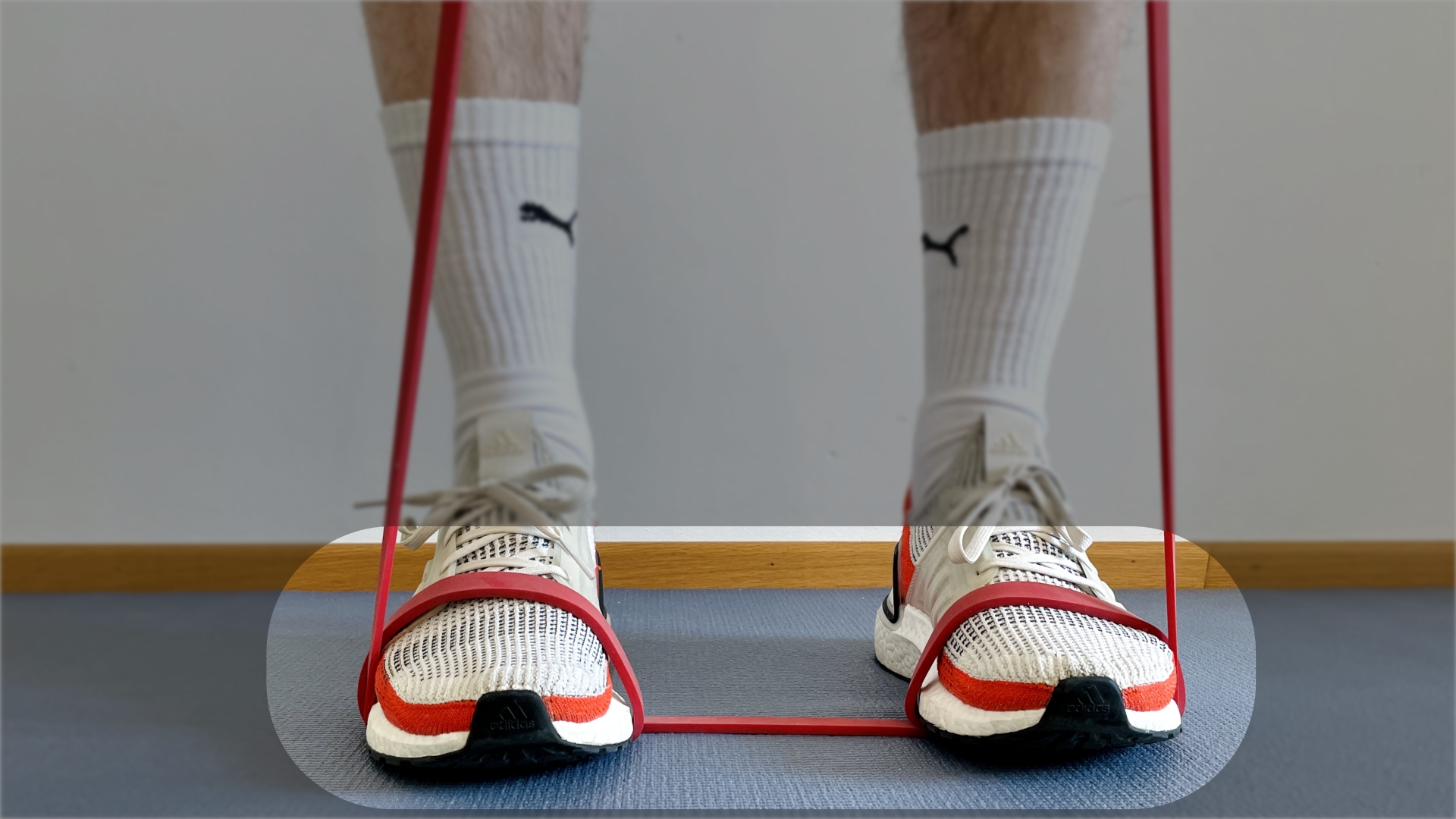
There are also some general mistakes to avoid when training with resistance bands. Check out the full list right here: The Worst Mistakes You Can Do When Training With Resistance Bands
How To Progress?
Adding more and more resistance by using thicker bands is not that comfortable when it comes to calf raises. At some point you will have to use a door anchor set-up or do single leg calf raises. These variations we will discuss in the next section. But you can also progress by using other methods than increasing resistance. And it is even more beneficial to use the following techniques first before jumping to the next thicker band.
Slow down the reps – This is magic when training your calves. Simply by slowing down the exercise speed, you can keep the resistance level the same and make it more challenging for your body. What I also really like to do is combining slow negatives with explosive positives. So you would be very slow and controlled on the way down and once your heels touch the floor you explode back up.
Extended Range of Motion – The range of motion in the standard version of calf raises is quite small. By increasing the range of motion, you also increase the total time under tension of this exercise. This will really challenge your calves in a new way and will force you to go down with the resistance.

Adding a lighter Band – That is one of the reasons of having a set of bands with different resistance levels is a good idea. Just grab the lightest band and add it to the one you’re using. This will increase the resistance enough without going overboard.
Doubling a Band – Instead of placing the band on your shoulders, you can also hold it next to your legs with your hands. This will also make it easier to keep the balance. By doubling the band in this position, you can really increase the resistance of a light band to a level there it becomes really difficult.
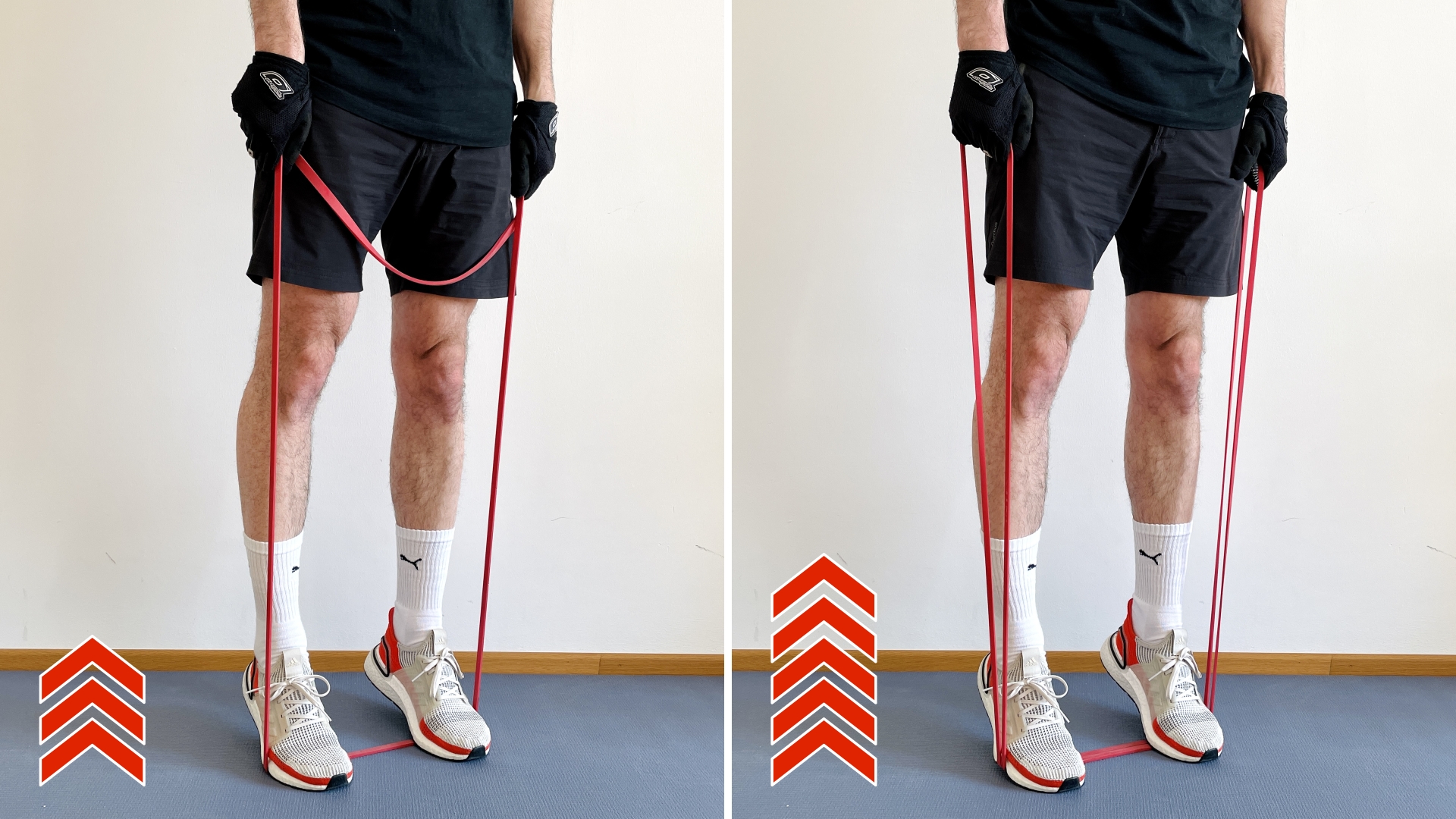
The BIQ App
Take training with resistance bands to the next level with our free app.
- 800+ Exercises
- all band types
- different training goals & workouts
- challenges
- much more
Alternative Ways To Do Calves Raises With Resistance Bands
There aren’t tons of variations to calf raises out there, but we still have some for you to try. This will make sure to keep your workouts interesting and your body won’t get used too quickly to the motion pattern.
Anchored Calf Raises (Extended Range of Motion) – I really enjoy this variation a lot for 3 reasons. The first is that I don’t have to worry about keeping the band secure under the balls of my feet. By using a door anchor and attaching the band to the bottom of a door, your feet will be completely free. If you still need a door anchor, here you go: Door Anchor
The second reason is that I can by simply taking a step forward or back adjust the resistance in the exercise. Step forward gives you an increased resistance – step back will lower it. You can even change it in the middle of a set. I really like to take a step back towards the end of a set and knock out a couple of extra reps.
The third reason is the extended range of motion, which is quite small in this exercise, and increasing it is actually really beneficial. The extension comes due to the forward lean you will have to do when using a door anchor.

Single Leg Calf Raises – when first starting out with fitness training, some exercises and motions can be quite a challenge. Not only you will have to move the resistance and concentrate on doing the exercise correctly, in case of calf raises there is also a balancing act to do. By doing the raises, one leg at a time and holding unto something or simply placing one hand against a wall, you can eliminate the balance topic and really focus on the movement and the muscles working.
The unilateral variation is also great if you are really strong and need a really heavy resistance band. At some point, it will be quite annoying to handle such thick bands. By performing the exercise with one leg only, you will have to use lighter bands. It will also help to get any imbalances sorted out.
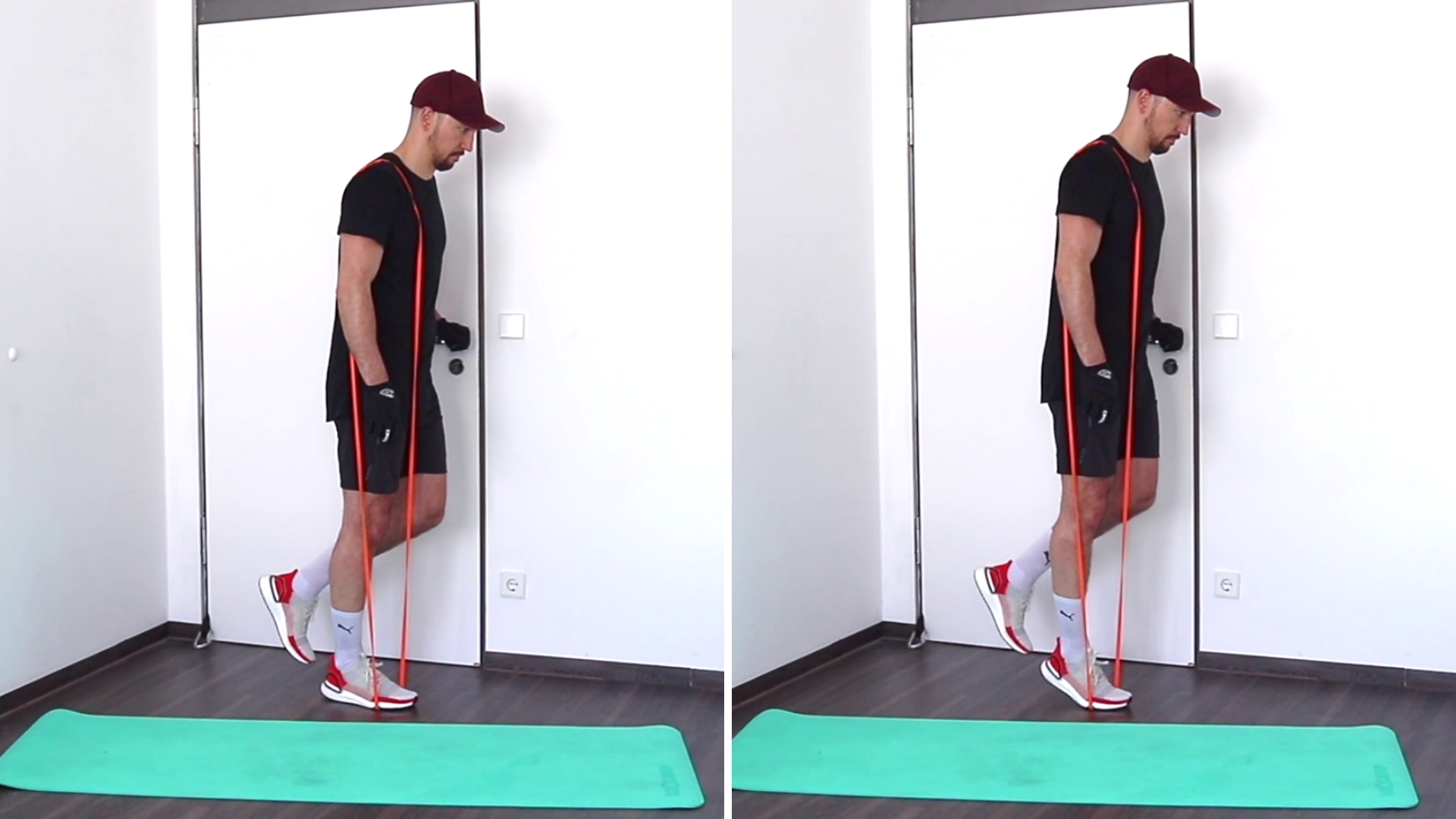
Can You Train Calves Effectively With Resistance Bands, and Why?
I would even argue that resistance band training is more beneficial, especially for calves, than working out with weights. First of all, there is still some stigma out there that resistance bands are way inferior to weights and are only useful for warming up or mobility work. People who think that often never really tried using resistance bands for some heavy training.
Human bodies can’t tell a difference between weights or bands. The only thing our bodies respond to is resistance. So if you have to move against a resistance, your body will respond to this added load by building strength, endurance and muscle. Over time, of course. And resistance bands are more than capable to generate that resistance.
A huge advantage of bands when it comes to training your calves is that the resistance curve of bands is actually progressive. This means the further you stretch a band, the more resistance it will generate. Calves respond to this kind of resistance profile really well. Also, it simulates real life functional movements, where you often have to do explosive movements and don’t have a static load.
If you want to find out more about the “Why”, check out our full article: Why Does Training With Resistance Bands Work
Benefits Of Training With Resistance Bands
If you are still not convinced why using resistance bands for your fitness training is a good idea, we have some more reasons for you why you should reconsider.
- Functionality! – Since bands have a linear variable resistance, it simulates much better real life movements than working out with a static load.
- Enforces good exercise form! – Cheating with bands is much harder than with weights. This way you will do exercises with good form from the start and make progress faster and safer.
- Safe! – Band are lightweight and only generate resistance when you stretch them. It is much more difficult to hurt yourself when working out with bands compared to weight training.
- Train anywhere! – These little tension creators will fit in any bag or suitcase. Therefore, you can get your fitness sessions in even if you have to travel for work or enjoying your holiday.
There are even more advantages, resistance band training brings along. A full detailed look in this topic you can find in this article: Benefits Of Resistance Band Training
What Muscles Are Used In A Resistance Band Calf Raise
It is actually really straight forward. The main muscles you will stimulate while performing a calf raise are calves, which are located on the back of your lower leg. Of course, there are different string of muscles which build up the calf muscles, but you will be using all of them anyway, so there is no benefit of knowing them unless you are a doctor.
Main Working Muscles:
- Calf Muscles
Workout Plan
Knowing how an exercise is done is only the first step. Doing it is the second, and actually implementing it in a workout routine is the third and most important step. Only if you do something on regular basis and give your body the necessary time to recover, you will make progress and come closer to reaching your fitness goals.
That’s where having a well build workout program comes into the picture. Among other things, it has to be suited to your goals and has to take into consideration how much time you actually have available to work out. Creating such a program yourself needs quite some research and experience. Especially in the beginning, following a workout program which is created by someone with experience is key to stay motivated and making progress.
Our goal is to provide you well-designed and engaging workouts in a well-structured program, so you only have to follow along, make progress and use the saved time for something more meaningful than research about exercise science. That’s why we created an app, so you can have easy access to workouts and additional background information about resistance band training. And all this on your mobile in your pocket at all times. To find out more, check out our app: BIQ Training App

